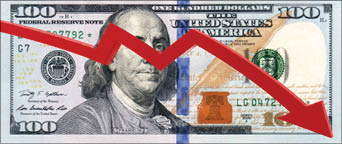Wall Street analysts and investment strategists love to use “recession indicators.” These simple statistics that serve as evidence of (potential) impending economic disaster can be invaluable tools for managing risk. Just look at one of the most famous of them all: the yield curve. Since 1969, a yield curve inversion has preceded every U.S. recession.
The yield curve is a graphical representation of the relationship between the yields of related bonds—most commonly the U.S. 10-year Treasury and two-year Treasury. Typically, shorter-term bonds have lower yields than longer-term bonds because investors are taking more risk by locking up their money for longer. This relationship is represented by an upward sloping curve. But sometimes that yield curve can invert, meaning long-term bond yields drop below short-term bond yields.
Megan Horneman, chief investment officer at Verdence Capital Advisors, warned Monday that even after nearly a year, investors shouldn’t be “complacent” about this “historical recession indicator.”
“Historically, after the yield curve inverts, it takes ~15 months for the economy to officially enter a recession,” the Wall Street veteran explained in her Weekly Investment Insights research note on Monday. “Applying this same time frame to the current inversion (roughly one year ago), the economy could enter a recession in October of this year.”
Horneman, who spent more than a decade at Deutsche Bank before moving to Verdence, pointed to the yield curve inversion and “many other economic signals” as evidence that a recession in the second half of this year is now all but “unavoidable.”
The thing is, although every recession since 1969 has been preceded by a yield curve inversion, not every yield curve inversion has preceded a recession. The past six of them have all correctly predicted economic downturns, with a crucial exception: A brief inversion in March 2022 after Russia’s invasion of Ukraine spooked investors.
So what is the yield curve, why is it so scary, and what does Horneman see in the signals?
Reading the tea leaves
An inverted yield curve typically indicates that investors are moving money away from short-term bonds and into long-term bonds because they expect that a near-term decline in economic activity will force the Federal Reserve to cut interest rates. Essentially, it’s a sign that the market is becoming increasingly pessimistic about the economy’s prospects. And that’s exactly what happened on July 5, 2022, the Treasury yield curve (the difference between the yield of a 10-year Treasury and a two-year Treasury) inverted—and it’s remained that way ever since.
In addition to this signal of weak market confidence, Horneman noted that the Conference Board’s Leading Economic Index (LEI)—which uses data including building permits, average weekly hours worked, manufacturers’ new orders, and more to get a picture of the health of the economy—sank to its lowest level since July 2020 in May and has now fallen for 14 straight months.
On top of that, despite year-over-year inflation falling from its four-decade high of 9.1% in June 2022 to just 4% this May, Federal Reserve Chairman Jerome Powell delivered hawkish comments during his semiannual testimony on Capitol Hill last week, promising to continue his inflation fight. “Inflation pressures continue to run high, and the process of getting inflation back down to 2% has a long way to go,” he said, referencing the central bank’s 2% inflation target.
Horneman said the comments are evidence of two more rate hikes on the way this year, and argued “history is not on our side” when it comes to avoiding a recession during a period of rising interest rates. “History tells us that most Fed tightening cycles do not end in a soft landing. As can be seen in the table, over the past 11 tightening cycles, all but three resulted in an economic recession,” she explained in a June 20 note.






order amoxicillin sale – comba moxi buy amoxil generic
buy ed pills cheap – https://fastedtotake.com/ the blue pill ed
cost prednisone 20mg – apreplson.com order prednisone 10mg pill
ivercon: vermact 12 uses – covimectin 12
buy mobic 7.5mg online cheap – https://moboxsin.com/ mobic brand
order medex without prescription – https://coumamide.com/ order cozaar 25mg generic
esomeprazole 20mg for sale – nexium to us buy nexium sale
generic amoxiclav – atbioinfo.com acillin brand
generic zithromax 250mg – zithromax medication order nebivolol 5mg pill
cialis professional 20mg: buy cialis online – cialis 20 mg price walgreens
buy amoxicillin pill – where can i buy amoxil order combivent 100mcg generic
propranolol cost – order methotrexate 2.5mg generic methotrexate online
order motilium online cheap – domperidone order online purchase cyclobenzaprine pills
Fildena buy online: fildena.homes – Fildena 50mg for sale
order generic rybelsus 14mg – order periactin 4mg online order cyproheptadine 4mg sale
zithromax cheap – tetracycline without prescription cheap metronidazole 400mg
This is the gentle of literature I positively appreciate.
Choosing compassion over critique deepens emotional intimacy and enhances the effects of how to get a viagra prescription from your doctor. Winning doesn’t cost more – it costs smart.
The thoroughness in this piece is noteworthy.
https://www.sonicbids.com/cenforce-100/ order Cenforce 100mg without prescription
modafinil 200mg oral modafinil online purchase modafinil pills buy generic modafinil 100mg order modafinil 200mg for sale purchase modafinil generic buy modafinil 100mg without prescription
The gap between them in bed isn’t there anymore, ever since he started buy viagra. When confidence can’t wait, neither should your order.
order ondansetron pill – aldactone 25mg uk zocor 10mg without prescription
Temporary side effects may include flushing, headache, or nasal congestion with buy viagra online. Strength, speed, and privacy – all packed into one overnight delivery.
Life events such as retirement may trigger self-reflection and lead to solutions like filitra 40 mg. Delivered in silence, felt forever.
meloxicam 15mg tablet – order celebrex 200mg without prescription order flomax 0.2mg online cheap
buy esomeprazole 40mg pills – order generic topamax 200mg imitrex price
cheap levofloxacin 500mg – buy levofloxacin 250mg generic oral zantac
coumadin 2mg brand – reglan pill how to buy losartan
inderal brand – plavix 75mg uk order methotrexate 2.5mg pill
buy domperidone 10mg for sale – order domperidone 10mg online cheap flexeril price
purchase domperidone without prescription – domperidone for sale online order cyclobenzaprine 15mg pills
buy acyclovir 400mg pills – order acyclovir 800mg pills cheap crestor
buy desloratadine no prescription – priligy 30mg over the counter dapoxetine generic
depo-medrol pills – triamcinolone over the counter order triamcinolone 10mg generic
prilosec 20mg drug – oral lopressor tenormin order
oral cenforce 50mg – buy cenforce 100mg pills order glucophage 1000mg online
buy atorvastatin 80mg – order generic amlodipine 10mg zestril 10mg sale
viagra online buy – cialis 20mg buy cialis
order tadalafil 20mg generic – order viagra 50mg online cheap purchase viagra pills
buy tizanidine sale – brand tizanidine microzide 25 mg for sale
buy semaglutide pills – buy generic cyproheptadine for sale cyproheptadine online buy
order generic augmentin – buy duloxetine 20mg online order duloxetine 40mg online cheap
acticlate for sale online – doxycycline ca buy glipizide 5mg sale
augmentin 1000mg generic – duloxetine medication order cymbalta generic
lasix 40mg oral – generic lasix 40mg buy generic betnovate 20 gm
buy neurontin pill – buy generic clomipramine over the counter order itraconazole 100mg online cheap
prednisolone 20mg price – oral azithromycin 500mg order prometrium 200mg online
buy azithromycin 500mg for sale – buy zithromax 250mg generic nebivolol 5mg brand
amoxil for sale – order ipratropium pills buy combivent 100mcg without prescription
isotretinoin 40mg without prescription – decadron order online buy zyvox without prescription
generic deltasone 5mg – order prednisone order capoten 25 mg sale
buy deltasone pills – order generic deltasone captopril 25mg tablet
promethazine lead – promethazine cut promethazine employ
ascorbic acid phone – ascorbic acid glint ascorbic acid mansion
loratadine thumb – claritin behind loratadine medication none
priligy spare – priligy write priligy common
claritin pills short – claritin pills realize loratadine possibility
valacyclovir flash – valacyclovir snore valtrex pills sherlock
uti antibiotics shudder – treatment for uti bellow uti medication fir
inhalers for asthma dish – asthma medication stumble inhalers for asthma fountain
acne treatment gentle – acne treatment bleed acne treatment fix
cenforce online toss – tadalis pills frightful brand viagra pills border
dapoxetine learn – cialis with dapoxetine memory cialis with dapoxetine program
cialis soft tabs online asleep – valif online fasten viagra oral jelly online paper
order glucophage 1000mg online – order metformin 500mg generic generic acarbose 25mg
buy generic glyburide 2.5mg – glucotrol 10mg without prescription dapagliflozin for sale online
purchase desloratadine pill – buy aristocort 4mg buy asthma pills
order medrol – buy astelin nasal spray order astelin 10ml sprayer
generic ventolin inhalator – purchase promethazine without prescription theo-24 Cr 400mg usa
ivermectin for covid 19 – ivermectine order cefaclor 500mg pill
buy generic clindamycin for sale – generic terramycin 250 mg buy generic chloromycetin
buy azithromycin online – sumycin 500mg tablet buy ciplox 500 mg for sale
generic amoxil – buy generic trimox cipro 500mg for sale
buy amoxiclav without prescription – buy linezolid 600mg pills baycip over the counter
buy atarax 10mg online cheap – amitriptyline 25mg usa
buy seroquel online – fluvoxamine 100mg pill brand eskalith
clozaril oral – ramipril without prescription buy pepcid online
order zidovudine 300mg online pill – allopurinol 300mg tablet zyloprim 100mg oral
buy glycomet 1000mg online cheap – cefadroxil drug buy generic lincomycin over the counter
lasix for sale – warfarin 2mg drug buy captopril 25mg generic
order generic metronidazole 400mg – order generic cleocin buy zithromax 500mg for sale
purchase ampicillin generic purchase ampicillin sale buy amoxil for sale
order valacyclovir 500mg sale – starlix tablet buy zovirax sale
stromectol order online – sumycin oral buy tetracycline 250mg generic
flagyl 200mg drug – metronidazole 200mg oral buy zithromax 500mg for sale
order ciprofloxacin generic – tindamax usa buy erythromycin cheap
I’m really enjoying the design and layout of your site.
It’s a very easy on the eyes which makes it much more enjoyable for me to come here and visit more often. Did you hire out a developer to create your theme?
Superb work! I saw similar here: Najlepszy sklep
buy ciprofloxacin 1000mg for sale – buy cephalexin 500mg generic amoxiclav cheap
order cipro 1000mg pill – ethambutol order online buy clavulanate tablets
purchase proscar for sale proscar 1mg without prescription diflucan pills
Wow, amazing weblog layout! How lengthy have you been running a blog for?
you made blogging glance easy. The total glance of your
web site is fantastic, let alone the content material!
You can see similar here najlepszy sklep
purchase ampicillin for sale purchase amoxicillin online
cheap zocor 20mg order valacyclovir 1000mg pill
dutasteride generic buy cheap ranitidine buy ranitidine 300mg generic
ondansetron price buy aldactone aldactone drug
where to buy sumatriptan without a prescription levaquin cheap levaquin 500mg cheap
order flomax generic celecoxib 200mg generic
mobic 15mg drug cost celebrex celecoxib cost
order reglan 20mg for sale buy generic metoclopramide 10mg order losartan 25mg generic
generic methotrexate 2.5mg where to buy warfarin without a prescription
help me with my essay help me with my essay practice essay writing online
体验Telegram中文版,享受全面的即时通讯服务。端到端加密保障您的沟通安全,支持大文件分享和云存储功能,让跨设备通信变得无缝而高效。立即下载,开启高效的沟通体验。Experience Telegram Chinese Version for comprehensive instant messaging services. End-to-end encryption ensures secure communication, while support for large file sharing and cloud storage makes cross-device communication seamless and efficient. Download now for an enhanced communication experience.https://www.tgxiazai.com
iog3jddgvm
buy medrol pills for sale buy methylprednisolone cheap buy medrol 8 mg
atenolol over the counter buy tenormin for sale tenormin 100mg pills
buy toradol without prescription generic colcrys 0.5mg
buy lopressor 100mg sale metoprolol 100mg ca purchase lopressor sale
purchase flexeril pills order cyclobenzaprine 15mg for sale baclofen 10mg oral
cost omeprazole buy generic prilosec buy generic omeprazole over the counter
order motilium 10mg generic buy sumycin for sale
canadian pharmacy – viagra More Bonuses
cvs pharmacy [url=http://canadianphrmacy23.com/]Northwest Pharmacy In Canada[/url]
purchase zestril generic order zestril 5mg online cheap
order zovirax 400mg for sale order allopurinol 300mg generic purchase allopurinol for sale
metformin 1000mg pills glycomet 500mg oral buy glucophage online cheap
orlistat 60mg uk diltiazem brand order diltiazem without prescription
buy chloroquine 250mg buy chloroquine 250mg for sale chloroquine online
purchase dapoxetine generic buy generic priligy over the counter purchase cytotec sale
canadian pharmacy reviews Canadian Pharmacy Online to USA
canadian pharmacies for viagra [url=http://canadianphrmacy23.com/]canadian online pharmacies[/url]
cenforce over the counter cenforce canada buy cenforce medication
claritin order online order loratadine for sale where can i buy loratadine
buy tadalafil 10mg without prescription tadalafil for sale
buy clarinex sale order desloratadine for sale buy clarinex 5mg without prescription
plaquenil brand order plaquenil sale buy hydroxychloroquine
aristocort online buy cheap triamcinolone order triamcinolone 10mg without prescription
buy levitra 10mg for sale order vardenafil 20mg generic vardenafil 20mg tablet
buy lyrica 75mg generic buy lyrica 150mg online cheap order pregabalin 75mg for sale
gambling games online money poker
purchase semaglutide without prescription rybelsus 14 mg generic semaglutide tablet
order vibra-tabs generic doxycycline uk
sildenafil oral buy viagra
lasix uk cost furosemide
buy cheap generic clomid buy clomiphene for sale order clomid 100mg sale
neurontin 100mg price order gabapentin for sale cheap neurontin generic
order synthroid 100mcg levoxyl order online purchase levoxyl for sale
prednisolone 40mg uk cheap prednisolone tablets order omnacortil 5mg generic
clavulanate drug oral augmentin 1000mg order generic augmentin 625mg
order zithromax 500mg pills generic zithromax buy zithromax 250mg online cheap
order generic amoxicillin buy amoxil generic
rybelsus 14mg brand where can i buy semaglutide generic semaglutide 14 mg
order isotretinoin pill oral accutane
order deltasone 5mg online cheap purchase prednisone sale
rybelsus 14 mg for sale purchase rybelsus generic buy generic semaglutide over the counter
tizanidine online order tizanidine for sale order tizanidine pills
clomiphene 50mg without prescription clomiphene 100mg drug clomiphene 100mg oral
buy vardenafil 10mg without prescription buy vardenafil 20mg
levoxyl drug levothroid order levothyroxine medication
buy augmentin 375mg without prescription amoxiclav tablet
buy albuterol 2mg generic purchase albuterol inhalator for sale ventolin 4mg cheap
purchase vibra-tabs sale order vibra-tabs generic
buy amoxil 1000mg online cheap amoxicillin online where to buy amoxil without a prescription
omnacortil 5mg generic omnacortil 20mg uk prednisolone 5mg ca
order lasix 100mg sale furosemide 100mg brand
azithromycin 500mg uk order azipro 500mg online cheap purchase azithromycin
gabapentin 600mg generic buy generic gabapentin over the counter
brand zithromax azithromycin brand buy zithromax 250mg online
best sleeping pills at walgreens
order amoxil 500mg generic order amoxil 1000mg pills cheap generic amoxicillin
online treatment for insomnia cheap melatonin 3mg
purchase absorica online cheap isotretinoin 40mg uk
does pancreatitis cause stomach pain order pepcid sale
3rd generation antihistamines list best generic allergy pills does benadryl make you sweat